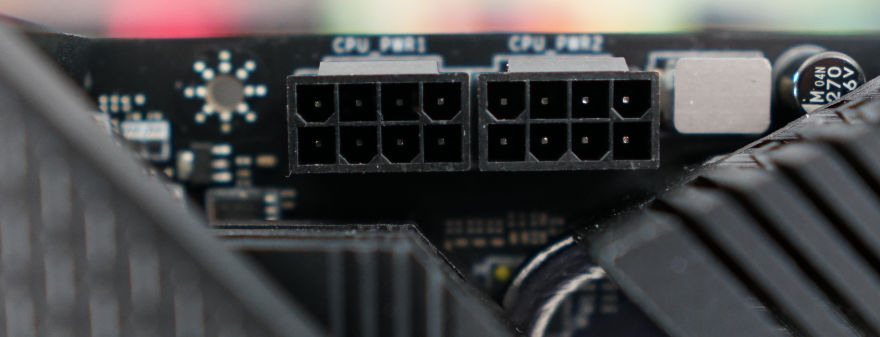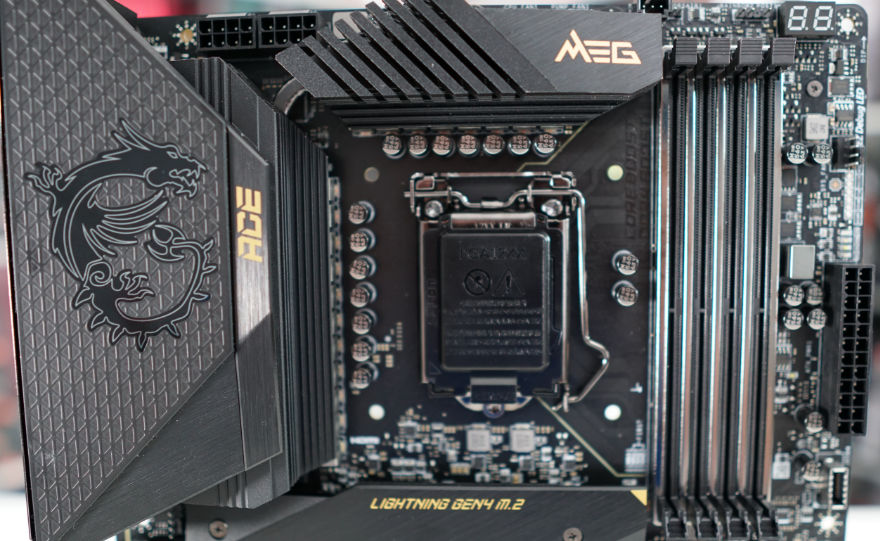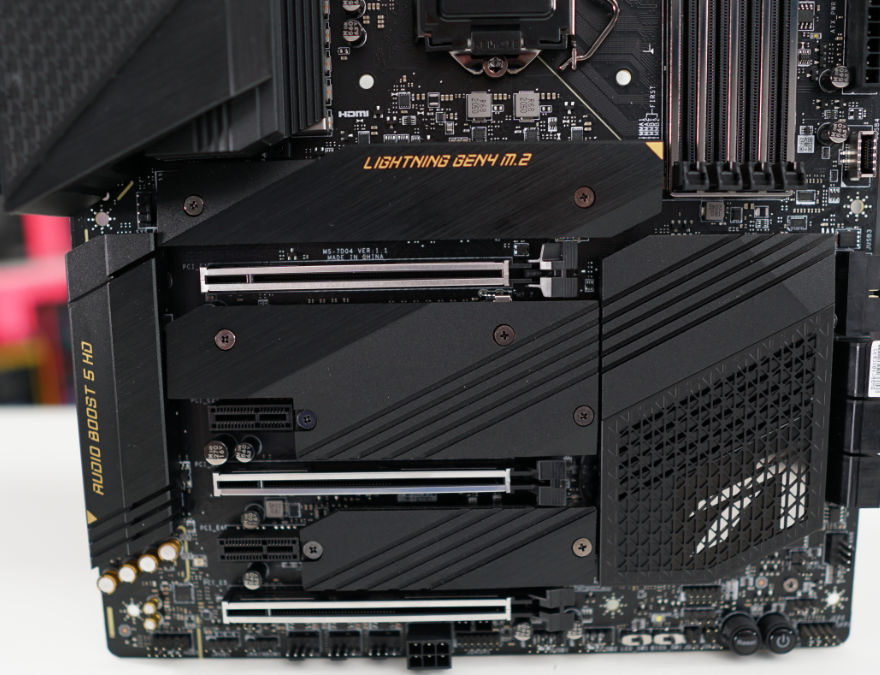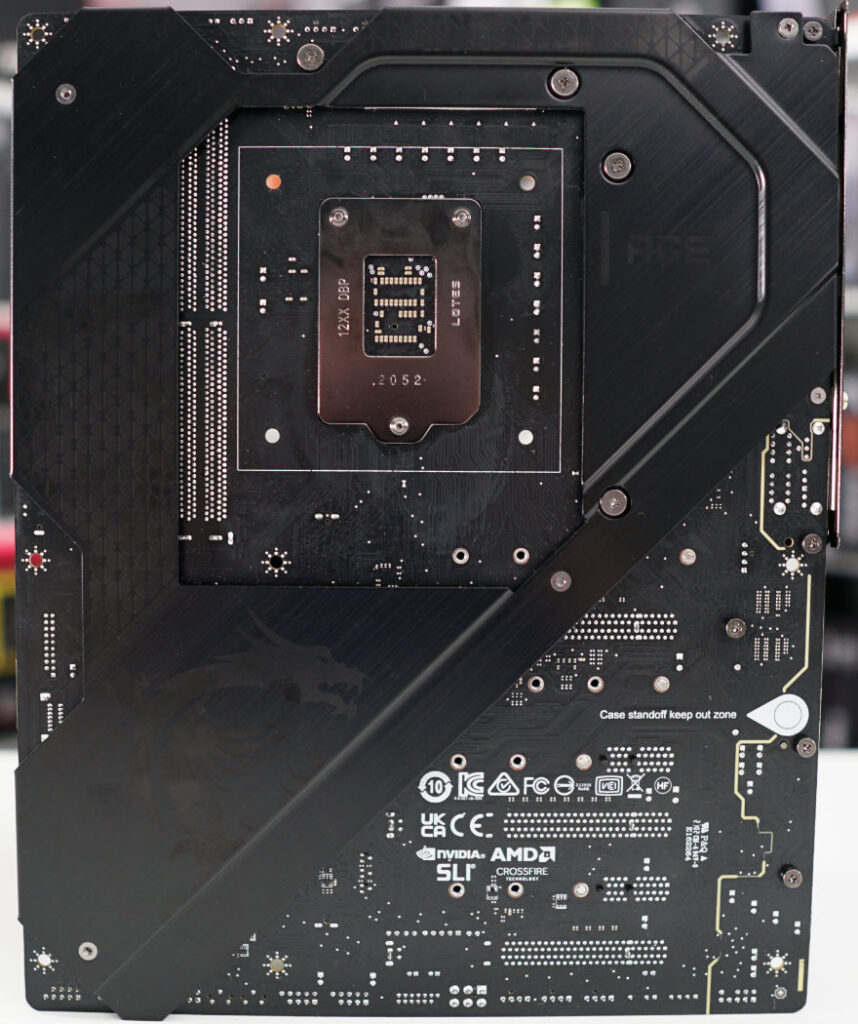MSI MEG Z590 ACE Motherboard Review
Ben Enos / 4 years ago
A Closer Look
Another mostly all black board but this time, MSI have gone with some gold text to add a nice bit of accent colour to things. Looking at the board as a whole and we can see most of the features we would want on an enthusiast-level board. Let’s take a bit closer look and dive a bit deeper into just what the MSI MEG Z590 ACE has to offer.

Dual 8-pin EPS power connectors are going to make sure our CPU is getting plenty of power and that this power is delivered efficiently. This will also help with the overall stability of the CPU, especially at load or when overclocking.

There are plenty of fan connectors on the board two of which can be found above the top VRM heatsink. We can also see an RGB header the EX Debug LED and another fan header just on the side of the board. The EZ Debug LED is a great way to see what is wrong with your board if it doesn’t post properly and makes life so much easier than trying to listen to beeps.

To aid the dual 8-pin EPS connectors, MSI has added eight Intersil Phase Controllers, a 16+2+1 Power Phase design with 16 x 90A Phases and 16 x Titanium Chokes for maximum power delivery, efficiency and stability.

When it comes to RAM, the MSI MEG Z590 ACE can support up to 128GB RAM in dual channel mode at up to 5,600MHz. This should be more than enough for damn near anyone on the planet and also allow for future-proofing. When it comes to gaming, we are just now seeing 16GB become the standard with some opting for 32GB in a just in case scenario. However, I am sure there are some content creators out there that could make 128GB of RAM cry at the same time.

On to the bottom half of the board and we have three PCIe x16 slots, all with extra protection on them and two standard x1 slots. In between all these PCIe slots, we have four M.2 slots under the heatsinks. The top slot is going to be our PCIe 4.0 slot that will only work with an Intel 11th Gen CPU. As for the others, they have a few different specifications:
The Chipset heatsink is rather large and fits in with the M.2 heatsinks quite nicely. There is also a hint of RGB in the chipset heatsink when the board is turned on.

To the right of the chipset, we have six SATA 6Gb/s ports and our front panel USB 3.2 port.

MSI has used the whole bottom of the board to add a load of connectors and headers to make sure that they have all the bases covered. From left to right we have the HD audio header, 12v RGB and 5x aRGB headers, 3x fan headers a 6-pin power connector that will deliver more power to our PCIe lanes for better GPU stability and overclocking, JDASH1 controller connector and pair of USB 2.0 headers.

Moving along we also have LED and BIOS switches. The BIOS switch is nice to have as even if nothing goes wrong you may want to switch between and overclocking BIOS and your normal day to day BIOS and this switch will make it seamless. We also have a couple more diagnostics jumpers, our reset and power buttons and finally, the header for the front panel connectors from a case. Again, MSI has done a great job at making sure this board is packed out with all the features you could want for standard gaming and even a bit of proper overclocking. They’ve all laid it all out nice and easy to find and use to make the experience just that much more enjoyable.

As this is a higher-grade board, standard audio just wouldn’t cut it. MSI has gone with an ALC4082 Audio Processor, ESS audio DAC, high-quality audio capacitors and even paired all of that up with a dedicated headphone amplifier for audiophiles and gold-plated audio jacks! MSI has even made this claim about the headphone amplifier “A dedicated headphone amplifier can drive audiophile headphones with up to 600Ω impedance”.

For the rear IO, as expected there is plenty of options to choose from! Here we have the following:
- Clear CMOS Button
- USB 3.2 Gen1 5Gbps (Type-A)
- USB 2.0
- 2.5G LAN
- Thunderbolt 4 40Gbps (Type-C)
- Wi-Fi / Bluetooth
- HD Audio Connectors
- Flash BIOS Button
- HDMI
- USB 3.2 Gen2 10Gbps (Type-A)
- Mini DisplayPort Input (for Thunderbolt passthrough)
- Optical S/PDIF-Out
What sticks out for me here is the dual Thunderbolt 4 ports, the Flash BIOS Button and the ever so handy Clear CMOS button.
The Thunderbolt 4 ports are going to allow for 40Gbps transfer, 8K display support and even daisy chaining! While this may not be widely used at the moment, the more motherboard manufacturers that implement the Thunderbolt 4 ports should mean other companies will likely make more products to utilize all that it has to offer.
The Flash BIOS Button is going to allow you to update the BIOS on this board without the need for a CPU while the Clear CMOS button does just that, clears the CMOS. This is great to have on the back of the board as it means you can access this even if installed in a case so should you make any mistakes in BIOS or have a bad overclock, you can easily reset the BIOS and start over!

The aluminium backplate offers a couple of benefits. The first is going to be added protection for the board so no matter how heavy a GPU or CPU cooler you install, the board will be able to handle it. The next and equally important benefit is it offers a unique way to dissipate heat from your Mosfet and even has a dedicate thermal pad to help aid this. We all know electronics like to get hot, especially when they have loads of stuff running through them. Seeing the backplate offer addition cooling solutions for the MSI MEG Z590 ACE is a well-welcomed features and just speaks volumes on MSI’s dedication to offering the highest of quality components to its user base.




















